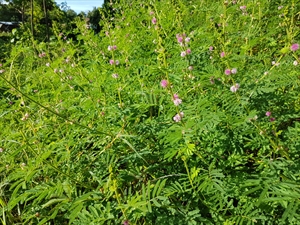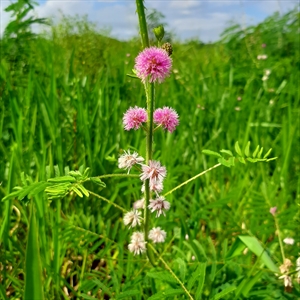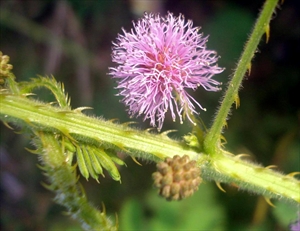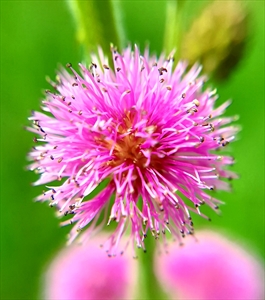- Widespread. Africa, Asia, North, South and Central America, Caribbean, Europe, Oceania. In most Pacific islands.
- Important, invasive, weed of plantations, upland rice, food crop gardens, pastures, roadsides, waste sites. Fast growing, smothering other species, flowering early and producing much seed with long survival. Cattle avoid it.
- Stems, 4-sided with short, stiff, backward-pointing thorns. Leaves, alternate along stems, bright green, 10-20 cm long, divided into 4-9 pairs of leaf-like segments, each with 12-30 pairs of leaflets. Flowerheads, a cluster of pink to purple, individual flowers, with long stamens forming fluffy balls, on short prickly stalks. Seedpods, soft, spiny, in clusters, breaking into 2-4, 1-seeded parts.
- Spread: seeds by birds, other animals, clothing, in flowing water; use as a ground cover; moved in road materials; as pasture seed contaminant.
- Biosecurity: high risk of introduction. Among 10 worst weeds in Fiji, Samoa, Solomon Islands. In Australia, 'restricted invasive plant': do not release into environment, give away or sell.
- Biocontrol: Heteropsylla spinulosa, psyllid, introduced into Australia, PNG, Samoa. Fungus, Corynespora cassiicola, has potential.
- Cultural control: before flowering, hand weed (use gloves or hoe!) or slash; vehicle hygiene.
- Chemical control: in Australia: dicamba; diuron; fluroxypyr; glufosinate-ammonium. In Fiji, glyphosate. Apply to regrowth after slashing or burning.









